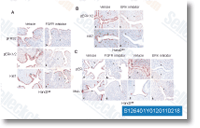Implementing the Comparative Toxicogenomics Database, we identified 25 genes with previously reported alterations in gene expression on BPA publicity that also harbored aberrant DNA methylation near promoters in our BPA exposed mouse liver samples. To carry out technical validation also as to identify real differential methylation target genes on BPA ex posure, the unique twelve samples together with 17 extra samples had been included within the validation set. Two on the validation loci had been located inside gene dig this promoter re gions, and so an alteration in methylation on BPA exposure may possibly lead to concomitant gene expression modifications. One among our candidate genes that gained methy lation on BPA exposure in our M NGS information was Myh7b.
Quantitative and CpG site certain validation utilizing the Sequenom EpiTYPER platform confirmed the enhance in DNA methylation within the promoter re gion of Myh7b within a monotonic dose dependent manner. The MYH7B protein is identified to interact with ESR2, and one among experienced the MYH7B estrogen response factors is found within an identified RAM. Regardless of the validated quanti tative adjust in methylation from the Myh7b promoter, no exposure dependent alteration in expression was observed in PND22 mouse liver samples. Throughout devel opment, genes exhibit one of a kind time windows of expres sion, and its probable a alter in expression might have been missed or could come about at a future time level. Alter natively, the observed altered methylation upon BPA ex posure could simply be an effect within the epigenome that will not manifest itself inside a modify in expression, protein degree, or protein activity.
Slc22a12 is really a candidate RAM displaying decreased degree of methylation upon BPA ex posure. In humans, the presence of single nucleotide polymorphisms within the SLC22A12 gene was observed to become linked with weight problems and metabolic syndrome in Caucasians  with hypertension. As inside the M NGS data, a substantial reduce in DNA methylation was ob served in samples within the UG publicity group, but not from the MG exposure group, including to the weight of evi dence supporting non monotonic epigenetic responses following BPA publicity. Our pathway examination indicated strong enrichment of genes concerned in metabolism and stimulus response on BPA exposure. This observation, in mixture with previously reported information supporting a part for BPA in immune and metabolic response, indicates the importance of alterations in epigenetic pathways following perinatal exposures like a mechanism linking developmental exposures to sickness chance in adulthood. Such as, the activity within the adiponectin gene, which codes for a hormone controlling insulin sensitivity, was previously shown to become suppressed by BPA, implicat ing BPA during the growth of type two diabetes.
with hypertension. As inside the M NGS data, a substantial reduce in DNA methylation was ob served in samples within the UG publicity group, but not from the MG exposure group, including to the weight of evi dence supporting non monotonic epigenetic responses following BPA publicity. Our pathway examination indicated strong enrichment of genes concerned in metabolism and stimulus response on BPA exposure. This observation, in mixture with previously reported information supporting a part for BPA in immune and metabolic response, indicates the importance of alterations in epigenetic pathways following perinatal exposures like a mechanism linking developmental exposures to sickness chance in adulthood. Such as, the activity within the adiponectin gene, which codes for a hormone controlling insulin sensitivity, was previously shown to become suppressed by BPA, implicat ing BPA during the growth of type two diabetes.
Microrna Synthesis
MiRNAs are abundant in many mammalian cell types.
